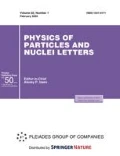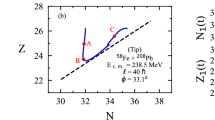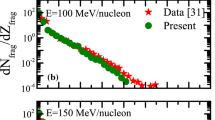Abstract
New results from a series of experiments dedicated to the study of the 12C exotic state (the so-called Hoyle state) are presented. In spite of the many investigations that have been carried out, the structure of this state (which lies above the threshold for breaking up into three alpha particles) is still unknown. The different models assume that the nucleus has an abnormally large size in this excited state. However, until recently, methods for measuring the radii of unbound states have not been suggested. The best way to solve this problem seems to be by measuring the angular distributions of elastic and inelastic scattering of 12C on different target nuclei, and the determination of the radii is based on the fact that, at small scattering angles, the cross sections for direct reactions at high enough energies behave like Frauenhofer diffraction on a black ball. Accordingly, an experiment was performed aimed at measuring the elastic and inelastic angular distributions of 12C with an energy of (121.5 ± 0.5) MeV on a 12C target. The elastic scattering was measured in the angular range from 18° to 50° in the c.m. system with uncertainty in the angle of measurement equal to Δθ = ± 0.6°. The inelastic cross section was measured for the 12C excited state 2+ (4.44 MeV) and 0+ (7.65 MeV). Estimates were made for the diffraction radii for the ground and excited states. An increase was observed in the radius of the state at 7.65 MeV compared to those of the ground and first excited states.
Similar content being viewed by others
References
A. S. Demyanova et al., J. Mod. Phys. E 17, 2118 (2008).
A. N. Danilov et al., Phys. Rev. C 80, 054603 (2009).
S. Kubono et al., Phys. Lett. B 163, 75 (1985).
B. R. Fulton et al., Phys. Lett. B 136, 322 (1984).
T. R. Ophel et al., Nucl. Instrum. Methods Phys. Res., Sect. A 272, 734 (1988).
R. Kalpakchieva et al., Soobshch. OIYaI R7-2003-132 (Dubna, 2003).
V. Z. Maidikov et al., Prib. Tekh. Eksp., No. 4, 68 (1979).
N. K. Skobelev, Fiz. Elem. Chastits At. Yadra 20, 1439 (1989) [Sov. J. Part. Nucl. 20, 613 (1989)].
A. V. Belozyorov et al., Nucl. Instrum. Methods Phys. Res., Sect. A 411, 343 (1998).
S. I. Fedotov, O. I. Kartavtsev, and A. V. Malykh, Eur. Phys. J. A 26, 201 (2005).
T. Sugimoto et al., Phys. Lett. B 654, 160–164 (2007).
J. A. Tostevin et al., Nucl. Phys. A 630, 340–351 (1998).
M. Zahar et al., Phys. Rev. C 49, 1540 (1994).
Author information
Authors and Affiliations
Additional information
Original Russian Text © V.A. Maslov, R.A. Astabatyan, V.A. Damaskin, M.P. Ivanov, R. Kalpakchieva, A.A. Kul’ko, S.M. Lukyanov, Yu.E. Penionzhkevich, R.V. Revenko, N.K. Skobelev, D.A. Testov, S.A. Goncharov, A.N. Danilov, A.S. Demyanova, A. A. Ogloblin, Z. Dlougy, 2011, published in Pis’ma v Zhurnal Fizika Elementarnykh Chastits i Atomnogo Yadra, 2011, No. 1(164), pp. 53–62.
Rights and permissions
About this article
Cite this article
Maslov, V.A., Astabatyan, R.A., Damaskin, V.A. et al. Study of the diffraction scattering 12C + 12C with the excitation of the 12C exotic state 0 +2 (the Hoyle state). Phys. Part. Nuclei Lett. 8, 31–36 (2011). https://doi.org/10.1134/S1547477111010080
Received:
Published:
Issue Date:
DOI: https://doi.org/10.1134/S1547477111010080




